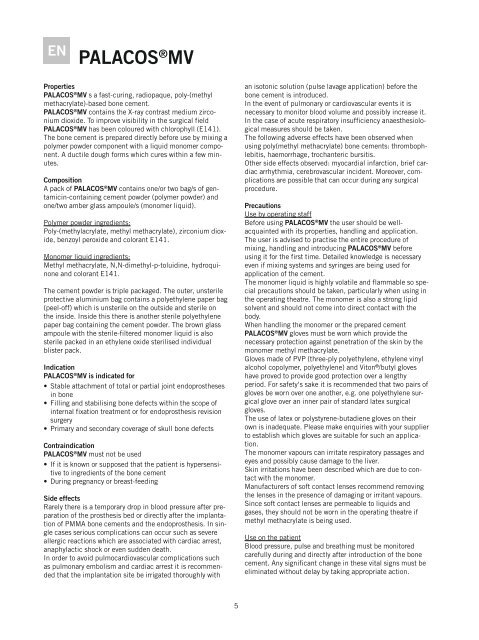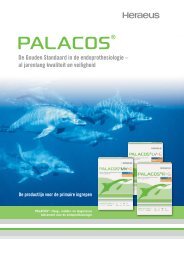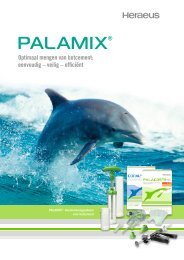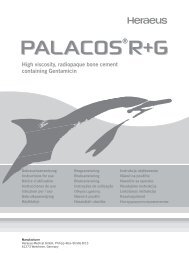Medium viscosity radiopaque bone cement
Medium viscosity, radiopaque bone cement - Heraeus Medical
Medium viscosity, radiopaque bone cement - Heraeus Medical
Create successful ePaper yourself
Turn your PDF publications into a flip-book with our unique Google optimized e-Paper software.
EN<br />
PALACOS ® MV<br />
Properties<br />
PALACOS ® MV s a fast-curing, <strong>radiopaque</strong>, poly-(methyl<br />
methacrylate)-based <strong>bone</strong> <strong>cement</strong>.<br />
PALACOS ® MV contains the X-ray contrast medium zirconium<br />
dioxide. To improve visibility in the surgical field<br />
PALACOS ® MV has been coloured with chlorophyll (E141).<br />
The <strong>bone</strong> <strong>cement</strong> is prepared directly before use by mixing a<br />
polymer powder component with a liquid monomer component.<br />
A ductile dough forms which cures within a few minutes.<br />
Composition<br />
A pack of PALACOS ® MV contains one/or two bag/s of gentamicin-containing<br />
<strong>cement</strong> powder (polymer powder) and<br />
one/two amber glass ampoule/s (monomer liquid).<br />
Polymer powder ingredients:<br />
Poly-(methylacrylate, methyl methacrylate), zirconium dioxide,<br />
benzoyl peroxide and colorant E141.<br />
Monomer liquid ingredients:<br />
Methyl methacrylate, N,N-dimethyl-p-toluidine, hydroquinone<br />
and colorant E141.<br />
The <strong>cement</strong> powder is triple packaged. The outer, unsterile<br />
protective aluminium bag contains a polyethylene paper bag<br />
(peel-off) which is unsterile on the outside and sterile on<br />
theinside. Inside this there is another sterile polyethylene<br />
paper bag containing the <strong>cement</strong> powder. The brown glass<br />
ampoule with the sterile-filtered monomer liquid is also<br />
sterile packed in an ethylene oxide sterilised individual<br />
blister pack.<br />
Indication<br />
PALACOS ® MV is indicated for<br />
• Stable attachment of total or partial joint endoprostheses<br />
in <strong>bone</strong><br />
• Filling and stabilising <strong>bone</strong> defects within the scope of<br />
internal fixation treatment or for endoprosthesis revision<br />
surgery<br />
• Primary and secondary coverage of skull <strong>bone</strong> defects<br />
Contraindication<br />
PALACOS ® MV must not be used<br />
• If it is known or supposed that the patient is hypersensitive<br />
to ingredients of the <strong>bone</strong> <strong>cement</strong><br />
• During pregnancy or breast-feeding<br />
Side effects<br />
Rarely there is a temporary drop in blood pressure after preparation<br />
of the prosthesis bed or directly after the implantation<br />
of PMMA <strong>bone</strong> <strong>cement</strong>s and the endoprosthesis. In single<br />
cases serious complications can occur such as severe<br />
allergic reactions which are associated with cardiac arrest,<br />
anaphylactic shock or even sudden death.<br />
In order to avoid pulmocardiovascular complications such<br />
as pulmonary embolism and cardiac arrest it is recommended<br />
that the implantation site be irrigated thoroughly with<br />
an isotonic solution (pulse lavage application) before the<br />
<strong>bone</strong> <strong>cement</strong> is introduced.<br />
In the event of pulmonary or cardiovascular events it is<br />
necessary to monitor blood volume and possibly increase it.<br />
In the case of acute respiratory insufficiency anaesthesiological<br />
measures should be taken.<br />
The following adverse effects have been observed when<br />
using poly(methyl methacrylate) <strong>bone</strong> <strong>cement</strong>s: thrombophlebitis,<br />
haemorrhage, trochanteric bursitis.<br />
Other side effects observed: myocardial infarction, brief cardiac<br />
arrhythmia, cerebrovascular incident. Moreover, complications<br />
are possible that can occur during any surgical<br />
procedure.<br />
Precautions<br />
Use by operating staff<br />
Before using PALACOS ® MV the user should be wellacquainted<br />
with its properties, handling and application.<br />
The user is advised to practise the entire procedure of<br />
mixing, handling and introducing PALACOS ® MV before<br />
using it for the first time. Detailed knowledge is necessary<br />
even if mixing systems and syringes are being used for<br />
application of the <strong>cement</strong>.<br />
The monomer liquid is highly volatile and flammable so special<br />
precautions should be taken, particularly when using in<br />
the operating theatre. The monomer is also a strong lipid<br />
solvent and should not come into direct contact with the<br />
body.<br />
When handling the monomer or the prepared <strong>cement</strong><br />
PALACOS ® MV gloves must be worn which provide the<br />
necessary protection against penetration of the skin by the<br />
monomer methyl methacrylate.<br />
Gloves made of PVP (three-ply polyethylene, ethylene vinyl<br />
alcohol copolymer, polyethylene) and Viton ® /butyl gloves<br />
have proved to provide good protection over a lengthy<br />
period. For safety‘s sake it is recommended that two pairs of<br />
gloves be worn over one another, e.g. one polyethylene surgical<br />
glove over an inner pair of standard latex surgical<br />
gloves.<br />
The use of latex or polystyrene-butadiene gloves on their<br />
own is inadequate. Please make enquiries with your supplier<br />
to establish which gloves are suitable for such an application.<br />
The monomer vapours can irritate respiratory passages and<br />
eyes and possibly cause damage to the liver.<br />
Skin irritations have been described which are due to contact<br />
with the monomer.<br />
Manufacturers of soft contact lenses recommend removing<br />
the lenses in the presence of damaging or irritant vapours.<br />
Since soft contact lenses are permeable to liquids and<br />
gases, they should not be worn in the operating theatre if<br />
methyl methacrylate is being used.<br />
Use on the patient<br />
Blood pressure, pulse and breathing must be monitored<br />
carefully during and directly after introduction of the <strong>bone</strong><br />
<strong>cement</strong>. Any significant change in these vital signs must be<br />
eliminated without delay by taking appropriate action.<br />
5






